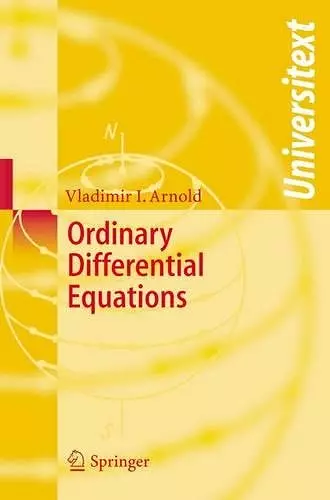Ordinary Differential Equations
Vladimir I Arnold author R Cooke translator
Format:Paperback
Publisher:Springer-Verlag Berlin and Heidelberg GmbH & Co. KG
Published:19th Jun '06
Should be back in stock very soon

The first two chapters of this book have been thoroughly revised and sig nificantly expanded. Sections have been added on elementary methods of in tegration (on homogeneous and inhomogeneous first-order linear equations and on homogeneous and quasi-homogeneous equations), on first-order linear and quasi-linear partial differential equations, on equations not solved for the derivative, and on Sturm's theorems on the zeros of second-order linear equa tions. Thus the new edition contains all the questions of the current syllabus in the theory of ordinary differential equations. In discussing special devices for integration the author has tried through out to lay bare the geometric essence of the methods being studied and to show how these methods work in applications, especially in mechanics. Thus to solve an inhomogeneous linear equation we introduce the delta-function and calculate the retarded Green's function; quasi-homogeneous equations lead to the theory of similarity and the law of universal gravitation, while the theorem on differentiability of the solution with respect to the initial conditions leads to the study of the relative motion of celestial bodies in neighboring orbits. The author has permitted himself to include some historical digressions in this preface. Differential equations were invented by Newton (1642-1727).
"Professor Arnold has expanded his classic book to include new material on exponential growth, predator-prey, the pendulum, impulse response, symmetry groups and group actions, perturbation and bifurcation … . The new edition is highly recommended as a general reference for the essential theory of ordinary differential equations and as a textbook for an introductory course for serious undergraduate or graduate students. … In the US system, it is an excellent text for an introductory graduate course." (Carmen Chicone, SIAM Review, Vol. 49 (2), 2007)
"Vladimir Arnold’s is a master, not just of the technical realm of differential equations but of pedagogy and exposition as well. … The writing throughout is crisp and clear. … Arnold’s says that the book is based on a year-long sequence of lectures for second-year mathematics majors in Moscow. In the U.S., this material is probably most appropriate for advanced undergraduates or first-year graduate students." (William J. Satzer, MathDL, August, 2007)
ISBN: 9783540345633
Dimensions: unknown
Weight: unknown
338 pages
1st ed 1992. 2nd printing 2006